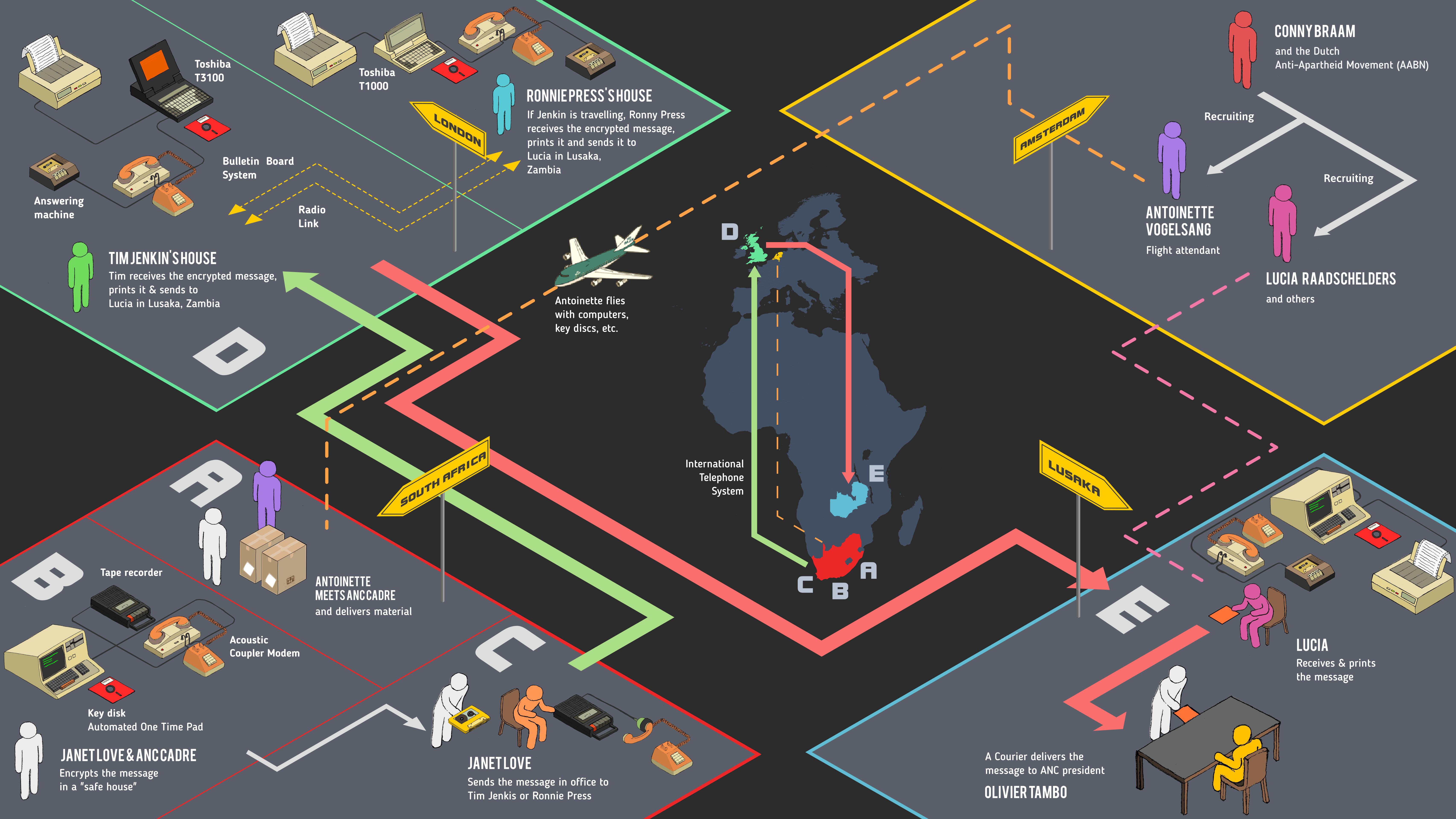The message excerpts have been edited for ease of reading.
This short introduction focuses only on an early version of the encrypted system, which was frequently updated over the years. Further, it is very much influenced by the article: Sophie Toupin, “Gesturing towards ‘anti-colonial hacking’ and its infrastructure,” Journal of Peer Production 9, September 2016, ➝.
“Operation Mayibuye,” Historical Papers Research Archive, William Cullen Library, University of the Witwatersrand, ➝.
Garth Benneyworth, “Rolling up Rivonia: 1962–1963,” South African Historical Journal 69, no. 3 (2017): 404–417.
Stephen Ellis, External Mission: The ANC in Exile, 1960–1990 (London: Hurst, 2012).
Sophie Toupin, “Technically Subversive: Encrypted Communication in the South African National Liberation Struggle” (PhD diss., McGill University, 2020).
Keith Breckenridge, Biometric State: The Global Politics of Identification and Surveillance in South Africa, 1850 to the Present (Cambridge: Cambridge University Press, 2014). See also Paul N. Edwards and Gabrielle Hecht, “History and the technopolitics of identity: The case of apartheid South Africa,” Journal of Southern African Studies 36, no. 3 (2010): 619–639.
NARMIC/American Friends Service Committee, Automating Apartheid: U.S. Computer Exports to South Africa and the Arms Embargo (NARMIC/American Friends Service Committee, 1982). See also Komitee Zuidelijk Afrika, Computerizing Apartheid: Export of Computer Hardware to South Africa, trans. Mohamed Munaf, Kirsten Olofsen, and Gert Slob (Holland Committee on Southern Africa, 1990).
South African Democracy Education Trust, The road to democracy in South Africa, vol. 3, International Solidarity Part 1 (Pretoria: Unisa Press, 2008). See also Part 2 of the same book.
AbdouMalik Simone, “People as Infrastructure: Intersecting Fragments in Johannesburg,” Public Culture 16, no. 3 (2004): 407–429.
See Sekibakiba Peter Lekgoathi, “The African National Congress’s Radio Freedom and its audiences in apartheid South Africa, 1963–1991,” Journal of African Media Studies 2, no. 2 (2010): 139–153; Guerrilla Radios in Southern Africa: Broadcasters, Technology, Propaganda Wars, and the Armed Struggle, eds. Sekibakiba Peter Lekgoathi, Tshepo Moloi, and Alda Romão Saúte Saíde (Lanham: Rowman & Littlefield, 2020).
The purpose of these airborne leaflets was to wake South Africans up to the anti-apartheid cause. See Tim Jenkin, Escape from Pretoria (London: Kliptown Books, 1987).
See Sophie Toupin, “Escape from Pretoria,” hack_curio, August 14, 2019, ➝.
A one-time pad is a form of symmetric cryptography that pairs a plaintext with a pre-shared secret key.
Prestel was seen as a way to deliver information services into British homes and display the content on television sets. As a declining power in geopolitics and global manufacture, Britain had decided to pivot to a new information economy in the 1960s, investing massively in videotext technology as a competitor to the American ARPANET system, the ancestor of the Internet. See John Carey and Martin Elton, “The Other Path to the Web: The Forgotten Role of Videotex and Other Early Online Services,” New Media & Society 11, nos. 1-2 (2009): 241–260.
Mac Maharaj in conversation with the author, November 2018.
See R. Kelly Garrett and Paul Edwards, “Revolutionary secrets: Technology’s role in the South African anti-apartheid movement,” Social Science Computer Review 25, no.1 (2007): 13–26. See also Padraig O’Malley. Shades of Difference: Mac Maharaj and the Struggle for South Africa (NY: Penguin Books, 2007).
Zarina Maharaj in conversation with the author, January 2019.
Tim Jenkin in conversation with the author, September 2018.
Conny Braam in conversation with the author, February 2019, and Frans in conversation with the author, February 2019.
Joe in conversation with the author, November 2018.
Janet Love in conversation with the author, October 2018, and Susan Tshabalala in conversation with the author, November 2018.
The two operatives, Mbuso Shabalala and Charles “Francis” Ndaba, were both killed by the apartheid regime.
Tim Jenkin in conversation with the author, September 2018.
Andy Clarno, Neoliberal Apartheid: Palestine/Israel and South Africa After 1994 (Chicago: University of Chicago Press, 2017).
Jem Bendell, “The Harry Potter of Jailbreaking: Tim Jenkin on Freedom,” YouTube, May 8, 2017, ➝.
